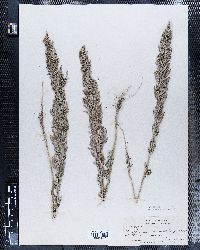Chenopodium desiccatum
|
Chenopodium desiccatum A. Nels.
 (redirected from: Chenopodium leptophyllum var. oblongifolium S. Wats.) (redirected from: Chenopodium leptophyllum var. oblongifolium S. Wats.) |
|
|
Family: Amaranthaceae
Arid-Land Goosefoot, more...aridland goosefoot, arid goosefoot, desert goosefoot, narroleaf goosefoot
[Chenopodium desiccatum var. desiccatum, moreChenopodium leptophyllum var. oblongifolium S. Wats., Chenopodium oblongifolium (S. Wats.) Rydb., Chenopodium pratericola subsp. desiccatum (A. Nels.) Aellen, Chenopodium pratericola var. oblongifolium (S. Wats.) H.A. Wahl] |
Stems erect to more often spreading, usually branched from base, 1-1.4(-6) dm, densely farinose. Leaves nonaromatic; petiole 0.3-0.4 cm; blade linear, narrowly lanceolate, oblong elliptic, or ovate-lanceolate, 3- (occasionally 1-)veined, 1.5-2.5 × 0.4-0.6 cm, 3-many times as long as wide, thick and somewhat fleshy, base cuneate, margins entire, unlobed, apex acuminate, densely white-farinose abaxially, more sparsely farinose adaxially. Inflorescences glomerules in terminal and axillary panicles; glomerules ± densely packed, flowers maturing irregularly; bracts leaflike or absent. Flowers: perianth segments 5, distinct nearly to base; lobes obovate, 0.8-1 mm, apex obtuse, carinate, densely farinose, enclosing fruit at maturity; stamens 5; stigmas 2, 0.1 mm. Utricles ovoid; pericarp nonadherent, smooth. Seeds ovoid, 8-1.1 mm diam., margins rounded; seed coat black, warty. 2n = 18. Fruiting mid summer-fall. Originally found in open undisturbed soils, prairies, and sandy stabilized dunes, but it has spread to disturbed open areas within its native range and beyond; 500-2000 m; Alta., Sask.; Calif., Colo., Idaho, Kans., Mo., Nebr., Nev., Okla., S.Dak., Tex., Utah, Wyo. Annual herb 10 cm - 0.6 m tall Stem: upright to spreading, branched basally, densely white-mealy. Leaves: alternate, on a 3 - 4 mm long stalk, 1.5 - 2.5 cm long, 0.4 - 0.6 cm wide, linear to narrowly lance-shaped to narrowly egg-shaped with a tapering base and pointed tip, typically three-veined (sometimes one-veined), thick, somewhat fleshy, sparsely white-mealy above, densely white-mealy beneath. Inflorescence: a small, more or less dense cluster of flowers (glomerule), white-mealy. Flowers: greenish, small, with five nearly distinct sepals and no petals. Sepal lobes to 1 mm long, reverse egg-shaped with a blunt apex, keeled, densely white-mealy. Stamens five. Stigmas two. Fruit: one-seeded (utricle), enclosed in the persistent sepals, egg-shaped, smooth, thin-walled. Wall (pericarp) loose and easily separable from the seed. Seed horizontal, black, shiny, to 1 mm wide, egg-shaped, round-margined, warty. Similar species: No information at this time. Flowering: late June to late August Habitat and ecology: Black Oak savannas, railroad ballast, and sandy waste ground. Occurence in the Chicago region: native Etymology: Chenopodium comes from the Greek words chen, meaning goose, and podion, meaning "little foot," referring to the leaf shape of some species. Author: The Morton Arboretum FNA 2004, Heil et al 2013 Duration: Annual Nativity: Native Lifeform: Forb/Herb General: Annual herb, 12-35 cm tall; stems erect or spreading, branched at base; herbage densely farinose. Leaves: Alternate and short-petiolate; petioles to 4 mm; blades entire and oblong to elliptic, mealy (farinose) below, more or less glabrous above, with 3 veins, much longer than wide, with a cuneate base and entire margins. Flowers: Inconspicuous, green, and clustered, the clusters (glomerules) arranged in spike-like terminal and axillary panicles; perianth segments, 5, densely farinose, the lobes obovate; flowers maturing irregularly. Fruits: Small ovoid utricles, the pericarp nonadherent, smooth; seeds ovoid, 1 mm, the margins rounded; seed coat black, smooth to rugose. Ecology: Open places, shrublands, and coniferous forests from 1,500-8,000 ft (460-2440 m), flowers May-September. Distribution: Spread throughout the intermountain west and into the plains states, north to Canada. Notes: Chenopodium is a genus of usually weedy annual herbs with simple, alternate leaves, herbage that is commonly farinose (with mealy, or floury hairs) to some degree, and clusters of small green flowers lacking petals, which mature into fruits composed of a single seed wrapped in the persistent calyx. C. dessicatum has narrow, oval-shaped leaves with generally entire margins without any lobes or teeth. The leaves are farinose but not as densely as C. incanum. Similar to C. leptophyllum but can be distinguished by its 3-nerved leaves (1-nerved in C. leptophyllum). Also, the pericarp is adherent to the seed in C. leptophyllum and not in C. dessicatum. In general, mature seeds are necessary for conclusive ID of any species within the Chenopodium genus. Ethnobotany: The leaves are edible and there are many other uses for species in this genus. Etymology: Chenopodium means goose foot in Latin, while desiccatum means dried, referring to its desert habitat. Synonyms: Chenopodium leptophyllum var. oblongifolium; Chenopodium oblongifolium; Chenopodium pratericola var. desiccatum; Chenopodium pratericola var. oblongifolium. Editor: SBuckley 2010, AHazelton 2015 |






























































































